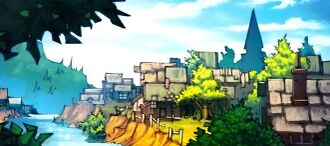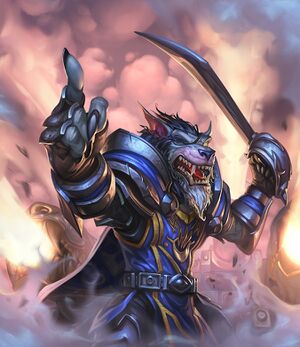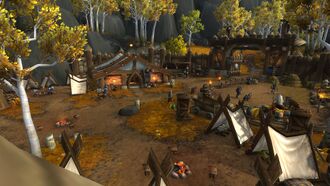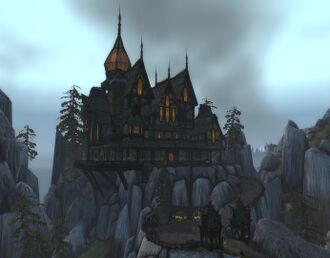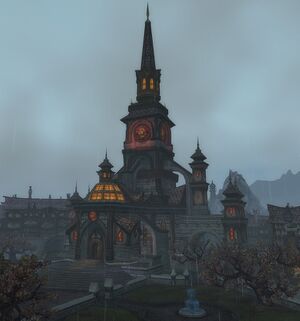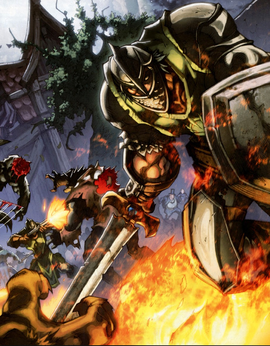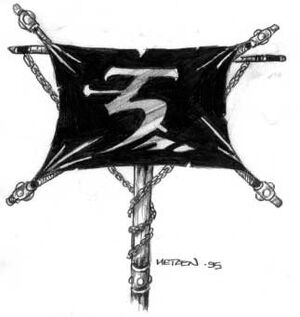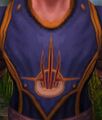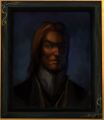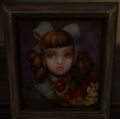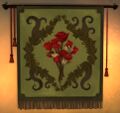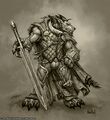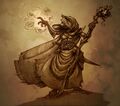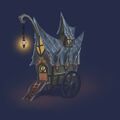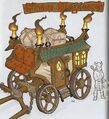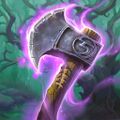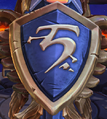Gilneas (kingdom)
- This article is about the human kingdom. For the region of the same name, see Ruins of Gilneas. For the starting area, see Gilneas (starting zone). For other uses, see Gilneas (disambiguation).
|
| |
| Main leader |
|
| Formerly | See below |
| Secondary leaders |
|
| Formerly |
|
| Race(s) |
|
| Capital | Gilneas City |
| Other major settlements | See below |
| Government |
Hereditary monarchy (Greymane family) |
| Language(s) | Common |
| Sub-group(s) | Gilnean military |
| Affiliation | Alliance, Church of Light |
| Formerly | Alliance of Lordaeron, Arathorian Empire |
| Status | Active |
| Reputation | |
| Tabard |
 |
“When I told some of you that I wanted to form an army to retake Gilneas City from these light damned Forsaken… There were those who said Gilneas City would never be retaken. That it was impossible. Well I say to you that we must no longer let our fears control us! For too long I let my fear control me… Fear that I had made all the wrong decisions… Fear that our nation would lose its identity… Fear that if all of you knew the truth, the whole truth… You would reject me as your leader. Well I give in to fear no longer. Look upon me now and see that which I have kept hidden. Now that you know the truth, I ask each of you… who will stand with me, who will fight by my side? Who among you will set aside your fear?”
The kingdom of Gilneas[2] (pronounced "Gil-NEIGH-uhs"), or the Gilnean kingdom,[3] is one of the seven human nations in the Eastern Kingdoms, and is located in the peninsula of Gilneas, situated southwest of Silverpine Forest on the continent of Lordaeron. Originally an Arathorian city-state founded after the Troll Wars, it became an independent kingdom after the empire split apart. The nation's colors are described as a red design consisting of a circle with three vertical lines, akin to lances, and another line bisecting the circle itself, all set within a field of gray.[4]
Led by King Genn Greymane of the Greymane family, the proud citizens of Gilneas once stood with the Alliance of Lordaeron against the orcish Horde that sought to conquer all of Lordaeron. When King Greymane severed ties with the Alliance following the Second War, the kingdom became independent from all other nations after the Greymane Wall was erected at the borders of its land. Unbeknownst to the rest of the world, darkness fell on Gilneas after the wall's gates had been closed during the Third War. Before long, Gilneans were fighting among themselves in a bloody civil war that left the nation in tatters. At the same time, a terrible curse transformed many citizens into savage lupine beasts known as the worgen, until the night elves taught them how to control their inner beast through the Ritual of Balance.
Following the Cataclysm, and the destruction of the Wall, Sylvanas Windrunner and the Forsaken started the Invasion of Gilneas on the orders of Warchief Garrosh Hellscream, who sought the land as a strategic port for his war's efforts against the Alliance. In their hour of greatest need, Gilneas called out for their old allies' aid and accepted Tyrande Whisperwind's offer to relocate the survivors to Darnassus. After the formal establishment of diplomatic ties with King Varian Wrynn, Gilneas added the ferocity of the worgen to the considerable might of the Alliance, intending one day to reclaim their lost kingdom.
Over a decade after their exile, King Genn Greymane and his people finally returned to Gilneas. With the support of the Alliance and the Desolate Council, they faced the forces of the Scarlet Crusade to regain control of their kingdom. In the aftermath of their victory, King Genn abdicated his throne to his daughter, Tess Greymane, who he deemed ready to lead their people to a better future as the Queen of Gilneas.
History
Early history
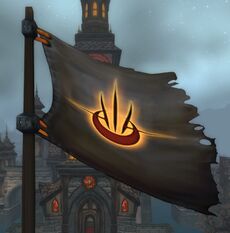
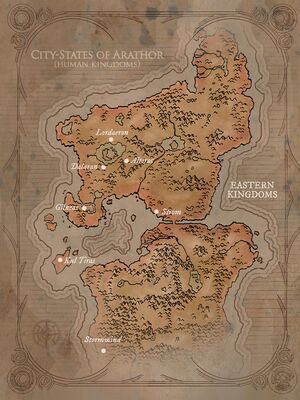
2,700 years BDP, following their victory in the Troll Wars, the humans of Arathor expanded their empire in size and power. After the death of King Thoradin, the empire founded new city-states in the wilderness - including Gilneas. Those who had settled in the coastal region of Gilneas constructed a series of robust harbors, until the boldest of the sailors left their homes and went to sea. They scanned the horizon day and night for a new home, seeking a place that married land and sea to shelter their children from the ocean waves. Among them, the ancestor of House Stormsong was the first to hear the whispers of the Tidemother, which taught him and others the power of the seas. The sea eventually guided them to a large island to the south that was rich with metal ores and other valuable natural resources. Some stayed and founded a mighty maritime outpost named Kul Tiras,[5] while tidesages were sent to guide others to come to the island as well.[6] On the island, the Gilnean colonists encountered the native vrykul known as the Drust,[7] and though they tried peace when they landed there, the Drust immediately went to war. They raided the humans' fledgling hamlets and settlements for generations, until a decisive conflict broke out between the two sides.[8]
Eventually, Gilneas' military became one of the most powerful in Arathor, equaled only by Alterac. Both kingdoms often combined their forces and led grand expeditions to secure the borders of Arathor, with one making contact with the dwarves and gnomes of Khaz Modan.[9] Over time the power of Gilneas and the other city-states grew as that of Strom waned, eventually they developed their own customs and beliefs. Its once-small trading outposts and cities had grown into independent city-states, which over generations became increasingly distant and insular, now only concerned with their own well-being. 1,200 years BDP, the empire splintered into independent kingdoms.[10] Unable to compete with Kul Tiras's burgeoning navy, Gilneas focused on bolstering its land-based armies and mercantile capabilities.
75 years prior to the First War, King Barathen Wrynn of Stormwind sent envoys to beseech Lordaeron, Gilneas, and the other human kingdoms for aid during the Gnoll War. But they would not send assistance, seeing no advantage in helping the smaller, rural nation, as Stormwind was self-sufficient and trade with the other kingdoms was rare.[11]
Under the rule of King Archibald Greymane, Gilneas entered into its industrial age, thriving and evolving into a formidable middle-power capable of rivaling even Kul Tiras or Stromgarde. When he was still the prince of Gilneas, Genn Greymane admired the sight of the capital with its industrial towers, large tiled roofs poised over cobblestone streets, shops, factories, and billowing smoke, and as a city with an eye toward the future, toward the potential of its people. After Archibald's death, Genn took the throne and led Gilneas much like his father had.[12]
Before the coming of the orcs, the human kingdoms of Lordaeron faced challenges and obstacles from each other as the games of politics played out.[13]
Second War and aftermath
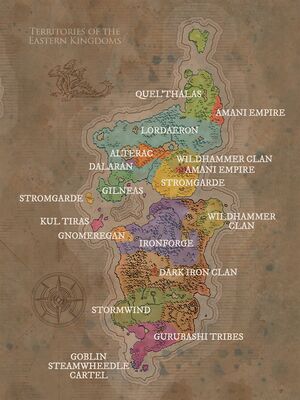
Following the First War and destruction of Stormwind City, the Council of Seven Nations was formed by Sir Anduin Lothar and King Terenas Menethil II with the intent of convincing the other kingdoms to band together to repel the invading Orcish Horde. However, Gilneas and Alterac were not as easily convinced because of Deathwing, who disguised as a human noble and spread rumors in Lordaeron that the tales of orcs were merely fabrications meant to hide growing problems with human rebels, which had seemed far more believable than Stormwind's cries for help. Consequently, both kingdoms showed open suspicion and believed that there had to be some other explanation.[14] Even when gnome and dwarf refugees arrived after the orcs conquested Khaz Modan, King Genn Greymane and King Aiden Perenolde stubbornly resisted calls for creating an alliance, as they feared that by unifying they would lose some of their regional power. Divisions widened between the kings, and the arguments grew so heated that Gilneas and Alterac threatened to abandon the council entirely. Nevertheless, this diplomatic incident was avoided when Turalyon, one of the most venerated priests in Lordaeron, presented himself with Prince Varian Wrynn at his side, and delivered an impassioned and charismatic speech of union to the assembly, which have got through to even the most doubtful present. The council later voted unanimously to form the Alliance of Lordaeron, comprising all of humanity's kingdoms.[15]
By the start of the Second War, Gilneas had become recognized as a significant entity in the political landscape of Lordaeron. Emboldened by this fact, King Genn Greymane, was not a strong supporter of the Alliance, believing that his own armies would be more than enough to deal with any threat.[16] However, wanting to ensure trade relations with the other kingdoms, Genn sent a token force to assist the Alliance.[12] At the same time, the king argued that he should assume the role of Supreme Commander of the Alliance, since Gilneas was the most southern of the kingdoms and that meant it would be first overrun if the Horde wasn't repelled.[17] He also insisted several times during the meetings that the Alliance forces should be stationed all around Gilneas’s borders in case the orcs somehow appeared there first.[18] During the war, Greymane held back his armies until the enemy finally attacked his own borders,[19] and was then said to have partaken in combat versus the orcs.[20] Some Gilnean soldiers joined Anduin Lothar's armies and fought against the Horde in Hillsbrad and the Hinterlands, though in lesser numbers than those sent by Lordaeron and Stromgarde.[21]
Shortly after the Horde was defeated, Turalyon spearheaded the efforts to rebuild the Eastern Kingdoms by gathering the rulers of each kingdom, who agreed to pool their resources to mend their war-ravaged nations.[22] However, Gilneas' desire to remain with the Alliance of Lordaeron soured, as they called for the extermination of the orcs instead of internment camps. However, Terenas Menethil showed them mercy and began building internment camps for them. In the years that followed, this bill coupled with the expenses that led to rebuilding Stormwind, and to make matters worse, as Gilneas refused to fund the construction of Nethergarde Keep, led to disagreements between the kings and eventually slowly drove the nation away from the Alliance of Lordaeron.[23]
When Alterac was occupied by Alliance troops for its treachery, Isiden Perenolde, a cousin of the royal family, fled to Gilneas in order to gather support. Greymane made a last bid during the Alterac crisis, trying to put Isiden Perenolde on the throne of Alterac to gain a direct stake in the kingdom's welfare and favored status through the realm's many mountain passes.[24] Both the Kirin Tor and King Terenas knew that King Greymane sought to intervene not only to raise his own prestige, but to further his dreams of expansion as a base in Alterac would give Gilneas access to resources they did not have, but also the excuse to send its mighty ships across the Great Sea. During the negotiations, Admiral Daelin Proudmoore was afraid that Gilnean influence in the region would threaten Kul Tiras' naval sovereignty.[19] However, the political attempt eventually failed and left King Greymane even more disillusioned with the Alliance of Lordaeron.
In a discussion with Lord Vincent Godfrey, King Greymane questioned the wisdom of listening to the advice of Crowley and Godfrey in joining the Alliance, stating that it had gotten them nothing but dead Gilneans. Greymane stated his plans to withdraw from the Alliance and wall off Gilneas from the rest of the world. Upon looking at the map of Gilneas, the King's decision to close Gilneas's borders and construct the great wall would cut through the lands of a newer, but still well-respected nobleman by the name of Lord Darius Crowley, as the noble's lands had the mountains as a natural barrier the wall could be built into. Should the wall be finished, it would separate the towns of Pyrewood Village and Ambermill from the rest of Gilneas. Greymane agreed and was confident that Crowley would understand his reasoning.[12] Since Gilneas was self-sufficient, and needed little in the way of food or resources from the rest of the Alliance, it was clear that Greymane had no interest in aiding the other nations.[25]
Third War and the Wall
Years later, while the Alliance of Lordaeron was unaware of the death cults forming in their lands before, the departure of Quel'Thalas who stated that the humans' poor leadership had led to the burning of their forests during the Second War,[26] alongside the liberation of the internment camps by Thrall, led to the departure of Gilneas from the Alliance. Consequently, King Greymane started the construction of the Greymane Wall, attempting to forever remove his nation from what he considered "other people's troubles". The construction was completed prior to the Third War.[27]
At the time of the Scourging of Lordaeron, King Greymane barricaded the majority of Gilneas behind the Wall and closed off the nation from the rest of the world. Gilneas was shielded from the rest of the world by land, but also by its high cliffs and treacherous reefs by sea.[28] As the Undead Scourge had devastated Gilneas' neighbors and not long after were outside the Wall, no one, not even human refugees were allowed to enter the kingdom, Genn even refused to help Lordaeron, who weeks before had begged Gilneas for help. The king saw the fall of Lordaeron as confirmation that he had made the right choice in isolating his kingdom from the world.[29] The lands of Lord Darius Crowley, including Pyrewood Village and Ambermill, were as planned separated by the wall.[12]
Prior the Siege of Dalaran, Lady Jaina Proudmoore worked tirelessly to rally as many refugees as she could after she had been convinced by the mysterious Prophet that sailing west to Kalimdor was the only course to save humanity. When she set sail for Kalimdor, her forces included members from nearly every Alliance race, including humans from Gilneas and other nations in the region.[30] As an act of defiance against the king, Lord Crowley sent a small group of soldiers known as the Gilneas Brigade to join the Human Expedition.[31] The Gilneas Brigade later became well-known for its valiance against the Burning Legion.[32]
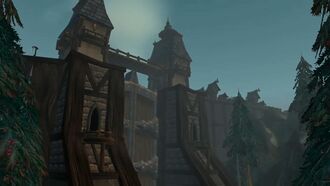
When the Scourge swept through Silverpine Forest, the residents of Pyrewood sought shelter but found the Greymane Wall closed to them. In order to survive, they departed on a ship called the Sea Wolf, heading for Stormwind City, until a storm blew their ship off course. They sailed aimlessly through the Great Sea for several weeks before another storm caused them to shipwreck on the shores of a mysterious island, near the ancient fortress of Black Rook Hold. Since their ship was unsalvageable, and the land plentiful, they built the village of Bradensbrook and settled down.[33]
At the peak of their strength, the Scourge relentlessly assaulted the Greymane Wall and threatened to devour all Gilneas. Their number was small at first, but it increased over time and they did not flag. King Greymane's armies held the wall for days against a massive sea of undead hordes, but for every undead that fell, another took its place.[12] Fearing it would break, King Genn Greymane opened the gate and Gilnean soldiers poured from Gilneas into Silverpine Forest. The Scourge, however, defeated the soldiers and raised them into undeath. Though the Scourge could not initially penetrate the wall, the Gilnean military was unable to repel the Scourge on their own, and it was only a matter of time before the undead would completely overrun their forces.[29]
In a desperate attempt to hold the seemingly-unstoppable Scourge at bay, Greymane ordered his court archmage, Arugal, to unleash a "secret weapon" against the Scourge: the worgen who had been contained for millennia in the Emerald Dream. At first, everything went according to plan, unfortunately, after the Scourge were driven off, the worgen turned on the Gilnean soldiers stationed beyond the Greymane Wall, infecting them with their Curse,[34] and began attacking other humans living in Silverpine Forest. Consequently, King Greymane ordered the return of his troops as well as the permanent closure of the Greymane Wall's doors, however, as some retreating soldiers were infected, they began secretly to spread the worgen curse. Over the years, reports of strange attacks and disappearances rose, fear took root in the hearts of Greymane's people, while the curse continued to spread in the kingdom through the Wolf Cult, gradually eating away at Gilneas' humanity.[1]
For many years King Greymane forbade any attempt to leave the self-isolated realm, and all ports were closed, leaving sailors and people of other nations stranded in Gilneas, such as the pirates of the Brashtide Crew.[35][36] Gilneans that were themselves locked out of their homeland were a rare sight, but not unknown, such as Baron Longshore, captain of the pirate ship "Heedless" in the Northern Barrens,[37] or the infamous murderer Stalvan Mistmantle in Duskwood.[38]
Northgate rebellion
- Main article: Northgate Rebellion
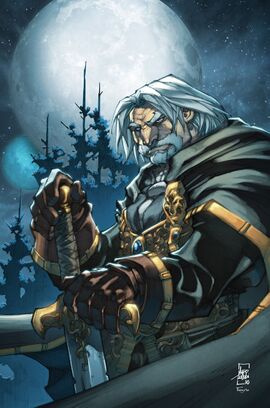
Although once a close friend of Genn Greymane, his staunch isolationism led Lord Darius Crowley to eventually take up arms against his king. Political divisions had led to a deep and bitter hatred between those known as "rebels" and "royals".[39][40] When the Northgate rebellion erupted in Gilneas, Crowley and his men immediately began to gain support among disgruntled Gilneans, and were labeled as terrorists and traitors by the loyalists. Leading his armed supporters into Gilneas City in an attempt to depose King Genn,[12] a bloody civil war erupted between the two factions, pitting Gilnean against Gilnean. The final, deciding moment of the conflict occurred when Crowley's army marched upon the capital city, setting it ablaze with artillery fire. Much street fighting likely followed, but the rebels were unable to overcome Greymane resistance. They were ultimately defeated, with the majority of its leaders, including Crowley, imprisoned for high treason within Stoneward Prison.[39]
Following the coup's failure and Crowley's imprisonment, the remaining rebels went into hiding. Many rebel weapon stashes throughout the city of Gilneas remained largely undiscovered.[41] As Gilneas returned once more to the unchallenged rule of King Genn Greymane, the kingdom however was left in a weakened state. Some time after, the Wolf Cult led by Alpha Prime infiltrated the kingdom and began terrorizing the forests of Gilneas. Fearful of causing panic following the civil war, King Greymane and several other nobles would secretly hold hunting parties during the full moons into the Blackwald to track down and shoot any feral worgen they came across.[12] Despite this, the worgen lurked throughout Gilneas for years, isolating the Gilnean harbor towns from support from the rest of the kingdom.[42]
World of Warcraft
Years after the Third War, refugees from Lordaeron and neighboring lands, under the care of Dalin Forgewright, tried to enter the kingdom but were stopped by the then-closed Greymane Wall.[43] Those refugees were not killed when the Scourge rampaged the land, and were presumably killed by the Forsaken and the worgen of Shadowfang Keep before the invasion of Gilneas.
Driven mad with guilt after the worgen slaughtered Baron Silverlaine and his servants, Arugal adopted the beasts as his children and retreated to Shadowfang Keep.[44] From there, Arugal cursed the remaining inhabitants of Pyrewood Village, so that they underwent a nightly transformation into the bestial Moonrage worgen, then returned to their human forms upon the arrival of dawn.[45] During the efforts to eradicate the worgen from Silverpine Forest, the Forsaken eventually disposed of Pyrewood Village and enlisted Horde adventurers aid to bring down its ruling council.[46]
Cataclysm
- Main article: Invasion of Gilneas
“The Forsaken think we're weak, a broken people. They think we'll roll over like a scared dog... how wrong they are. We will fight them in the fields until the last trench collapses and the last cannon is silenced. We will fight them on the streets until the last shot is fired, and when there is no more ammunition, we'll crush their skulls with the stones that pave our city. We will fight them in the alleys until our knuckles are skinned and bloodied, and our rapiers lay on the ground, shattered. And if we find ourselves surrounded and disarmed, wounded and without hope; we will lift our heads in defiance and spit in their faces. But we will never surrender! FOR GILNEAS!”
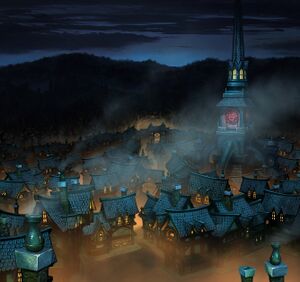
Unbeknownst to many of the kingdom's citizens, a war between beast and man raged within the worgen themselves.[48] To compound the worgen threat, the Forsaken started battering at the nation's gates in a bid to conquer Gilneas. Under orders from Garrosh Hellscream, now Warchief of the Horde, Sylvanas Windrunner was commanded to conquer the lands of Gilneas to secure resources[49] and its safe ports. Meanwhile, Sylvanas had her own objective – the retrieval of the Scythe of Elune, an artifact capable of summoning complacent worgen that could spread their curse to all humanity.[50]
Several days prior the Wolfcult's attack, King Genn ordered his son, Prince Liam, to increase the presence of the military across Gilneas, concerned with the growing number of attacks across the kingdom, of which included the Starlight Slasher murders. When questioned on whether these troops should be moved from the wall, Genn refused to allow it, stating the Forsaken would use any opportunity to exploit a weakness on the wall. Not wanting to alarm the civilians with the sudden upsurge of military forces, Liam was instructed to state that the Northgate rebels were acting up again.[51]
On the day of the worgen's attack, the capital was put under complete lockdown, and the Greymane Court was the first quarter to fall to the hands of Alpha Prime who orchestrated the attacks across the city.[52] Among the beasts were the Bloodfang pack who, according to statements from Ivar Bloodfang, hold resentment towards Gilneas for having abandoned them and having left them to die beyond the Greymane Wall.[53] After the fall of Merchant Square, King Genn ordered the release of Lord Darius Crowley and the Northgate rebels from Stoneward Prison,[39] who left behind them the grudges and rivalries of the civil war, and agreed to let Greymane's forces make use of their hidden artillery stashes across the capital.[54][55] The survivors later regrouped at the Greymane Court, where Crowley and his men accepted a suicide mission to attract as many worgen as possible to the Cathedral Quarter, while Genn ordered the evacuation to Duskhaven.[56] While the civilians discreetly left the capital, the rebels fought until they were overwhelmed and became worgen themselves in Light's Dawn Cathedral.[57][58][59]
With the aid of the night elf Belysra Starbreeze, a secret counselor of Greymane, many worgen traveled to Tal'doren in the Blackwald to perform the Ritual of Balance, helping them control their curse by achieving a balance between man and wolf. Meanwhile, the Royal Chemist Krennan Aranas also created a potion to temporarily restore the sanity of several captured feral worgen in Duskhaven.[60][61]
However, the Gilneans' respite was to be short-lived, as the Cataclysm destroyed some of the jagged reefs that protected Gilneas from the sea and breached the famed Greymane Wall itself, allowing the Forsaken to pour into Gilneas by land from Silverpine as well as land at Duskmist Shore.[62][28] As the Forsaken invasion progressed, the whole south-west of Gilneas began collapsing into the sea, destroying Duskhaven.[63] During the initial breach, the military had managed to hold off the Forsaken's advance at the Greymane Wall, they fought with muskets, burning oil, and flaming arrows, as well as having several of the recently cured worgen on the walls aiding them.[64] After being evacuated to Greymane Manor due to the earthquakes, the Gilnean survivors fled to Stormglen Village, while Greymane and Lord Vincent Godfrey traveled to Tal'doren to ask Darius and his worgen to help unite Gilneas against the Forsaken. Due to Godfrey's tyrannical command, Crowley was hesitant to accept, until Greymane asked him as a friend and not a king, and then revealed that he too had succumbed to the worgen curse. Now united by something even more important than the Gilnean law, they agreed to join forces.[65]
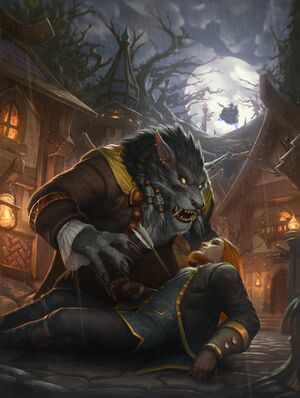
Following the death of Alpha Prime, King Greymane decided to stop concealing his infection and let his people know that he too was afflicted by the curse. Now united, rebels and loyalists, humans and sane worgen, accepted him as their leader and rallied when he called for a counterattack against Sylvanas Windrunner and her armies.[1] During the battle for Gilneas City, the Gilnean Militias led by Prince Liam fought their way through the capital, destroying the Forsaken forces positioned there. They soon united with Lord Crowley's worgen forces around Stoneward Prison, where they destroyed the flesh beast Gorerot. As the tide was turning against her, Sylvanas aimed a poisoned arrow at King Genn, however, Liam jumped in front of the bowshot to save his father from certain doom, dying with the knowledge that the city had been freed from Forsaken control.[66] In the aftermath, after they learned that the Forsaken were going to use the New Plague on the capital, Genn made the difficult choice not to pursue Sylvanas but to respect his son's wish of assuring the safety of their people first.[67] Everyone was then evacuated to Aderic's Repose by passing through the hidden Undertaker's Pass.[68][69] At the same time, the Val'kyr of Sylvanas raised the fallen Gilnean humans into Forsaken.[70]
When the survivors arrived at Keel Harbor,[71] a fleet of night elven ships appeared on the coast. Once again the strangers from across the sea had come to help Genn Greymane and his people.[72] As promised by Belysra, the night elves brought ships as well as an offer of sanctuary in their lands. Despite an assault of the Forsaken and their Horde allies,[73] the port was secured, and all of the Gilnean survivors boarded the transport ships. While a large amount of soldiers and volunteers remained to form the Gilneas Liberation Front under the leadership of Darius Crowley, Admiral Nightwind took the survivors to safety at Rut'theran Village in Darnassus.[74] Driven by their curse and the threat of the Forsaken, Gilneas was finally driven back into the Alliance's fold, owing a great debt to the night elves who helped heal the minds of many who fell victim to the worgen curse.[75] Once the civilian populace was evacuated to Teldrassil,[76] the kaldorei granted them asylum within the Howling Oak, which was grown by the night elven druids from a seed taken from Gilneas, now standing for all the Gilneans have endured during the kingdom's fall and all that their people have since accomplished.[77]
Wolfheart
After they evacuated to Teldrassil, many Gilneans were living in the woods until the Alliance summit, while a secluded clearing was prepared for those wishing to undergo the Ritual of Balance.[78]
Since Gilneas' official induction was dependent on the approval of the other Alliance representatives, King Greymane made his introduction at the welcoming banquet in Darnassus, where he admitted to the Alliance representatives that walling off his kingdom was a mistake; a mistake that cost them greatly, and thanked the Alliance for giving Gilneas a second chance. The Alliance dignitaries generally seemed accepting of Greymane's apology until the situation became tense with King Varian Wrynn's arrival, who implied that the Gilneans were pathetic cowards and weaklings. Despite the insults to him and his people, King Greymane held his anger in check and tried to persuade the king of Stormwind that Gilneas had changed, and that they were now ready to be staunch supporters of the Alliance. However, Varian absolved himself of any association with the desperate nation, still bitter over Gilneas' abandonment of the Alliance during their hour of need during the Third War. Nonetheless, King Genn noticed Goldrinn's presence around Varian and still held out hope that he would later change his mind.[20]
As Genn Greymane and the representatives from Gilneas met with the delegates from the Alliance, it was decided to make a show of power so that the Alliance would recognize the kingdom of Gilneas as a formidable ally, rather than a drain on the faction. As a result, the Gilnean military marched in formation with their king, carrying the banner of Gilneas and playing the Gilnean anthem. They had, despite Gilneas' beleaguered state, made a point of matching the amount of forces sent by the Stormwind army during this encounter, and capstoned this display by having the soldiers in procession transform into worgen. While the Alliance approved of the benefits and many began to support Gilneas' readmission, the king of Stormwind pointed out that he could never trust nor forgive Gilneas and that the Alliance has no need for such fair-weather friends, even after recognizing the benefits brought by Gilneas. This left the summit in an uproar and effectively ruined any chance Gilneas had of joining the Alliance.[4]
During the Ashenvale war, when the Horde marched into Ashenvale led by Garrosh Hellscream, with several magnataur under his command, the Gilnean forces attacked the magnataur en masse to aid King Varian Wrynn. With the worgen reinforcements and Varian's leadership, the tide of battle turned and the Alliance was able to drive out the invading army.[79] In the aftermath of the battle, Varian called for a second Alliance summit, this time being a proponent and supporter for the induction of the worgen. After Gilneas was officially voted into the Alliance, King Varian assured his allies that the Alliance would prevail and would do so with honor with the worgen at their side.[80] In turn, the Gilneans vowed to fight for their faction and to die for it if need be.[81]
Aftermath
Now in the Alliance, Lord Crowley and his loyal worgen, the Gilneas Liberation Front, renewed the war against the Forsaken and advanced as far as northern Silverpine Forest. At this point, they were able to seize Pyrewood Village as a defensive position, until Sylvanas's forces took it back, though at cost and in the face of fierce resistance. Using a gnomish submarine to break the Horde's blockade,[82] the elite 7th Legion spearheaded a vast Alliance offensive to reclaim all of Lordaeron from the Forsaken, starting with Gilneas[83] The combined forces of the Alliance, Gilnean, and now-allied Bloodfang worgen quickly pushed the Forsaken past the Greymane Wall. However, the Horde managed to rally in Silverpine, and Crowley later surrendered to Sylvanas after she took his daughter hostage, threatening her with undeath. This signaled an end to the Alliance offensive in Silverpine, although the Bloodfang Pack expanded their activities into the Hillsbrad Foothills.[84]
During the exodus, many refugees of Gilneas came to the Blasted Lands, following the dream of an idealistic druid named Marl Wormthorn. Upon their arrival, Wormthorn believed that the Tainted Scar could be healed, and attempted to grow it back by creating the great tree Maldraz with his power. At first, it was a success and the forest was restored, allowing the refugees to build Surwich. However, it also lured the majority of demons still present in the scar, and some dreadlords took the opportunity to corrupt the great tree and the Gilnean druid, leading to the birth of the Tainted Forest.[85][86] At some point, a large number of Gilnean ships sailed towards Surwich, with only civilians aboard.[87] However, the inhabitants of Nethergarde Keep reported that after a few days a storm brought some ships back to the Shattershore, revealing that they had sunk for unknown reasons and that their drowned occupants were haunting the coast.[88]
In Kalimdor, the Talonbranch pack settled in Felwood to learn the ways of nature and uphold its balance, but also to find a new way of life in this cursed land. According to their leader, Denmother Ulrica, several of their worgen had been around since Velinde Starsong first summoned the worgen with the Scythe of Elune, making them night elven worgen, while the others are Gilneans who suffered through the fall of their kingdom.[89] Together, they made Talonbranch Glade their base of operations and sought to heal the corrupted forest, but also to defeat the Burning Legion demons and stop the Bilgewater Cartel goblin's lumber operations in the region.[90]
A group of Gilneans led by Oliver Harris traveled to Raven Hill in Duskwood,[91] where they set up camp and began working on a cure to help the mindless worgen running rampant in the region.[92]
At Mount Hyjal, some Gilnean worgen have been corrupted by the Twilight's Hammer[93] and served them as mindless beasts.[94] Others joined the Cenarion Circle as guardians of Goldrinn's shrine.
At some point, a black drakonid disguised as Lord Hiram Creed manipulated a group of Gilnean humans and worgen named the Blackhowl to control Gilneas City. He secretly infected them with his draconic blood, which made them stronger but also unwittingly slowly turned them into his unwilling servants.[95] In his crusade to eliminate all corrupted black dragons on Azeroth, Wrathion sent his rogue champion to assassinate Creed.[96] Following Creed's fall, both the Horde and Alliance withdrew from Gilneas' mainland for unknown reasons,[97] leaving the only area of activity in the zone along the coastline where the Alliance forces fought the Horde as the Battle for Gilneas raged on.
Mists of Pandaria
After the defeat of Garrosh Hellscream in the Siege of Orgrimmar, High King Varian Wrynn said that the Alliance would cleanse Gilneas from the plague and keep Sylvanas Windrunner at bay.[98]
During Garrosh's trial, King Greymane announced his veto on the entire proceeding and accused the Horde leaders of being complicit in their Warchief's crimes, who led his troops against the people of Gilneas and slaughtered them like a butcher. He then asked that all of them should be put on trial, arguing that some like Sylvanas had even launched their own attacks. However, Taran Zhu calmly refused and explained that such would take quite a while, and that not all of them had long lives.[99]
Legion
During the third invasion of the Burning Legion, the Gilneas military forces participated in the Battle for Broken Shore. Under King Greymane's leadership, the Gilneas Brigade established Greywatch in Stormheim as their main base of operations to locate the Aegis of Aggramar on the Broken Isles.[100] Eventually, the Brigade uncovered that the Forsaken meant to plague Greywatch like they did Gilneas,[101] and King Greymane commanded his forces to destroy the plague caches and the invading forces of Sylvanas Windrunner.[102] Following the battle, the Gilneas Brigade was deployed across the Broken Isles and contested the Warden Towers against the Queensguard, going back and forth over control and attack of each tower.[103]
The Silver Enclave was renamed as the Greyfang Enclave after Dalaran was teleported to the Broken Isles, and became the headquarters of the Alliance in the city with Gilnean guards to protect it.
In Val'sharah, Bradensbrook was attacked by night elven ghosts of the Rooksguard raised by Gul'dan within Black Rook Hold.[104] The Gilnean residents endured until they received help from Jarod Shadowsong and the adventurers to fend off the undead. The Burning Legion later sent Imp Mother Gothol[105] and Nanosh the Slicer to attack the village,[106] but they were respectively destroyed by agents of the Unseen Path and the Council of the Black Harvest. During the Assault on Val'sharah, cups of demon blood were placed in the town by an infiltrated agent, and anyone who drank it was driven mad and mind-controlled. On the orders of Cenarius, the heroes freed the citizens and drove the invading demons back.[107]
By the time of the end of the Argus Campaign, the kingdom was referred to as fallen, with nothing but "wind, sorrow and ruin" in the land.[108] When Genn arrived at Stromgarde Keep before the events of the Gathering, he told Anduin that both kingdoms were now in ruins, with Gilneas being home to the Forsaken and Stromgarde being overrun with criminals, ogres, and trolls.[109]
Battle for Azeroth
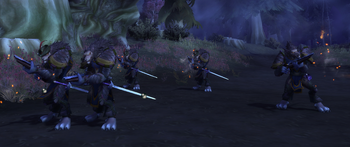
During the War of the Thorns, Sylvanas hoped to use the ruined status of Gilneas as an inciter among the Alliance after Teldrassil was captured. She erroneously attributed Genn Greymane's desire to reclaim his kingdom to cloud his judgment, causing a division within the Alliance between supporters who wished to reclaim Teldrassil and those who wished to reclaim Gilneas. Unbeknownst to Sylvanas, Greymane immediately claimed that Teldrassil would need to be reclaimed first, with Gilneas coming after, as a gesture to repay the debt owed to the night elves by the Gilnean people.[110] King Anduin later ordered that the portals from Darnassus must be constantly open throughout Stormwind City, and many night elven and Gilnean refugees arrived in the capital,[111] filling all its quarters, and even spilling out most of the way to Goldshire.[112] It was Queen Mia Greymane, as a respected authority figure, who appeased the Gilnean people at the Howling Oak and organized their evacuation.[113] All the Gilnean refugees were evacuated before the fire started and moved to Stormwind City,[114] where they settled around Olivia's Pond.
At the beginning of the Fourth War, Gilneas participated in the Battle for Lordaeron. The Bloodfang Pack also established a foothold once more on Fenris Isle after defeating Deathstalker Hayward, leading to the Forsaken needing to pull their forces out of position in order to evacuate across the Lake.[115] At the same time, Darius Crowley led an offensive into Hillsbrad Foothills,[116] preparing an army of their own to attack Gilneas.[117] The 7th Legion also sent aid under the command of Captain Tobias Zaren, surrounding Shadowfang Keep which was in the hands of Forsaken Apothecaries under the leadership of Chief Plaguebringer Harris, attempting to unleash a new bio-weapon upon the Gilneans to the south.[118]
In order to use Stromgarde as a launching point to attack Gilneas, the Horde forces moved towards the Arathi Highlands and attempted to take control of the city of Stromgarde to prevent the Alliance's full control over the Eastern Kingdoms.[119]
After Stormwind refused to send aid to Darkshore, due to their forces being spread too thin, Gilneas opted instead to aid the Kaldorei.[120] King Greymane sent a large force, led by Lorna Crowley and Princess Tess Greymane to aid their allies on their warfront as a part of the Army of the Black Moon; as well as to show the Alliance had not abandoned the night elves. He stated this was to repay the elves for everything they had done for Gilneas.[121] During the Battle of Dazar'alor, King Greymane deployed his Gilnean soldiers against the orc grunts and their Zandalari allies at the Port of Zandalar, with the king himself leading the strike team against King Rastakhan alongside Master Mathias Shaw of the SI:7. At the time of the Battle at the Gates of Orgrimmar, Genn and his troops were tasked by High King Anduin Wrynn to flank the orcish city and successfully captured the western gate.[122]
One of the Island Expedition's locations was Havenswood, home to an abandoned Gilnean settlement and castle.[123] It was inhabited by feral worgen, Old God minions, and dark necromancers.[124] Whatever remained of the inhabitants have been transformed into worgen, and while the males appeared to almost all be feral,[125] the women druids seemed to have some semblance of control. Lord Woofington was given his title after the rest of the denizens of the island succumbed to madness.
At some point, the night elves of the Temple of Elune in Val'sharah established active trade ties with the neighboring Gilnean village of Bradensbrook, sending and receiving supplies to and from the villagers via ships.[126]
After the war, a set of Scarlet Brotherhood propaganda pamphlets could be found near the Calston Estate in Tirisfal. They advised members of the order to rally behind King Genn Greymane and help him wipe out the Forsaken, after which they would turn on Greymane and destroy the worgen as well in order to ensure that Lordaeron belongs only to "pure-blooded humans".[127]
Dragonflight
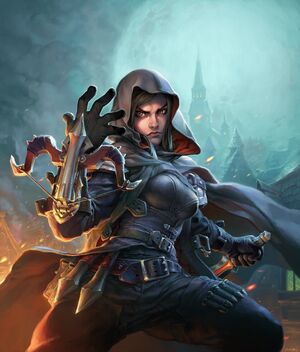
Shortly after the end of the war against the Primalists, King Greymane declared that the time had come to reclaim Gilneas. However, following their defeat against the Forsaken in Silverpine Forest, the Scarlet Crusade managed to weasel their way into the peninsula and transformed Gilneas City into their new stronghold in Lordaeron. Led by Inquisitor Fairbell, they made their headquarters within Light's Dawn Cathedral and filled the capital with their most experienced forces.[128] From Keel Harbor, Princess Tess Greymane was placed in charge of the operation and organized the Gilnean and 7th Legion troops. Despite Genn's opposition, she also appealed for support from Lilian Voss and Calia Menethil of the Desolate Council, the Forsaken being experts in fighting the Scarlet zealots.[129]
Like the undead, the Scarlet Crusade judged the worgen as monsters tainted and warped by the curse, and therefore as heretics to be purged from Azeroth. In time, they received orders to kill all worgen on sight and began exhuming the bodies in Aderic's Repose to burn their bones and "return" them to the Light.[130] They were later stopped by the adventurers sent by King Genn, who refused that the Gilneans who sacrificed themselves for the kingdom were defiled in this manner.[131]
During the Reclamation of Gilneas, the Forsaken forces bombarded the holy shields set up in the Cathedral Quarter, creating a diversion for their allies to infiltrate the capital through the Undertaker's Pass.[132] After the most experienced forces of the Crusade were eliminated, Princess Tess opened the gates of the Greymane Court to begin the reconquest of Gilneas City.[133] While fights broke out across the capital, the largest battle took place in the Cathedral Quarter, where the Gilneans faced the most powerful zealots.[134][135] After Inquisitor Fairbell was eliminated by King Genn, Princess Tess, Calia Menethil, and the adventurer in Light's Dawn Cathedral,[136] the allied forces gathered in the courtyard to celebrate their victory. On the steps of the cathedral, that Genn reaffirmed his faith in his daughter and abdicated as the ruling king of Gilneas, declaring that Tess would henceforth reign as the new queen of Gilneas, ready to lead their people towards a better future.[137]
With Gilneas at last secure, the kingdom returned to the hands of its people while the Forsaken withdrew their forces as promised. In time, all the villages across the peninsula saw the return of their population, while the capital was largely restored by the Gilnean Workers, who could still be seen repairing the damage caused by the numerous conflicts over the past decade.
People and culture
“Our people are not merely worgen. We are Gilnean, as we always have been, and always will be, cursed or not.”
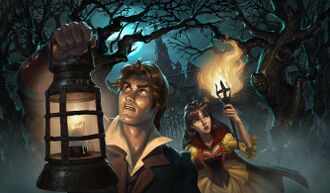
Gilneas' national color is black, and the kingdom's banner is described as a field of gray with a series of red lances; though its original depiction was a runic symbol upon a black banner. The lance symbol is seen specifically on their banners, flags, and tabards. The runic symbol is still used in several places, both in artwork as well as the worgen racial crest and on Gilnean shields.[139][140] Gilneas has its own national anthem[4] and patriotic battle cry,[20] which seems to be "For Gilneas!".[47][51] The nation is known for its unique atmosphere, as its distinctive character was epitomized both by the inhabitants' style of dress and by the cobblestoned streets and foreboding architecture of Gilneas City, which were unlike anywhere else in the world.[141] Wolves and roses appear to be common symbols of Gilneas, since both of them adorn the kingdom's coat-of-arms. Lieutenant Thorn expressed her patriotism by saying that her blood "runs rose red".[142]
A person from Gilneas is referred to as Gilnean.[143][144][145] Free from outside influence, the kingdom of Gilneas relied only on the indomitable spirit and tenacity of its citizens to make its own destiny in the world.[146] Gilneans have a culture of self-reliance. They are proud, stubborn, and loathe to accept the aid of outsiders.[12] If there was anything to distinguish the Gilneans from most other humans, it would be a wariness in their gazes as they neared. It is not a look of distrust but rather of defiance, yet, defiance not against anyone in particular but at the world in general.[20] Of late, however, a series of events that occurred during the Cataclysm has shaken Gilneas to its core.[146] Recognizing the evil and chaos that had taken over the world, the Gilneans have begun to acknowledge that they serve an important role in safeguarding the sanctity of Azeroth, and in doing so, have embraced the Alliance cause of fighting for a just and peaceful world.[12] Now, these self-disciplined worgen and tenacious humans have rejoined the Alliance as powerful allies, prepared to fight to keep their humanity and their place in society.[146]
Since Gilneas has become strongly industrialized and technologically advanced under the impulsive of King Archibald Greymane, they have many factories and use mechanical structures such as the river-powered waterwheel mills at Emberstone Village and the Waterworks, or the windmills at the farmsteads around Duskhaven. When he was still the prince of Gilneas, Genn admired the sight of the capital with its industrial towers, large tiled roofs poised over cobblestone streets, shops, factories, and billowing smoke, and as a city with an eye toward the future, toward the potential of its people.[12] Gilnean forces also heavily use firearms and artillery such as cannons, riffles, and guns more than any other human nation. The rapier is a weapon widely used by the Gilneans, particularly by their militiamen, which symbolically inspires their forces in battle.[47]
Gilneans are often accompanied by mastiffs, either as hunting hounds or as wardogs,[147] and some were used to hunt down the savage worgen.[148] Mountain horses have served Gilneans since before the First War, they are known for their strength, ferocious demeanor, how they are comfortable with their riders, and their proclivities to embrace their feral side.[146] Images of them are often found on kegs of watered-down dwarven brew.[149] Vicious Gilnean warhorses are born, bred, and, battle-tested in Gilneas. Gilnean gryphons are stronger than the native gryphons of the Broken Isles, and may be able to carry a 2,000-pound cannon.[150] Hippogryphs are also used by the Gilnean forces since their encounter with the night elves.
While many Gilneans kept their human name after being cursed, such as Darius Crowley and Tobias Mistmantle, some changed it for one with a lupine theme like Ivar Bloodfang, or Lord Geoffery Tulvan (known as "Lord Geoffery Wildwolf" once he turns).
Political structure
- Main article: Nobles of Gilneas
The kingdom of Gilneas possesses a hereditary monarchy with the Greymane clan[151] as the ruling line of the nation. They rule from Greymane Manor, and hold executive power over the nobles, the treasury, the military, laws, and administration. While Gilneas does not appear to have a formal governing body of nobles, like the House of Nobles in Stormwind City, the nobles of Gilneas are responsible for holding tracts of territorial land for the crown, and hold political clout with the king whom they serve as advisors. Lord Vincent Godfrey was notably the commander of Gilneas' standing militia.[12] At the royal court, Greymane also employed the royal chemist Krennan Aranas and the royal archmage Arugal at his service.
Gilnean municipalities are organized into governing townships.[152] They are composed of a variety of administrative officials: mayors,[153] lord mayors, and town councils. Mayors are responsible for the daily governing of municipal townships, they notably exercised some control over the mobilization of the local militia.[28] Pyrewood Village once had a town council composed of nine councilmen, presided by Lord Mayor Morrison as the executive head of the political organization.[154]
Without much information, Lord Godfrey mentioned a Gilnean law that binds all of its citizens.[155] The Gilneas City Guard preserve the civil order of the capital and work closely in association with criminal investigators and detectives, such as Halford Ramsey and Cox during the investigations of the murders committed by the Starlight Slasher.[156] Like the other realms, Gilneas can apply the death penalty for its criminals, the task being accomplished by an executioner through hanging or beheading, as gallows and guillotines are present in the courtyard of the Stoneward Prison.
Faith and folklore
Founded centuries ago in Lordaeron, the Church of the Holy Light spread its faith in Gilneas[157] and its citizens became followers of the Holy Light. The kingdom has its own clergy,[158] and Gilneas City itself is dominated by the Light's Dawn Cathedral. Many of the graves in Aderic's Repose notably feature the symbol of the Church.
Due to its relative isolation, Gilneas has also retained a degree of ancient pre-Arathorian culture into the contemporary era in the form of harvest-witches, practitioners of nature magic locally referred to as the "old ways", and living on the fringes of society. These "druids", who were driven to the edge of extinction once before,[159] used their nature powers to augment Gilneas' agricultural output during and following its period of industrialization,[160] and once saved the kingdom from a devastating famine by calling on the earth's blessings to restore the failed harvest.[159] After coming into contact with the night elves, harvest-witches who had contracted the worgen curse were offered induction into the Cenarion Circle to become true druids.[160]
Following the spread of the Worgen curse, many are naturally drawn to and revere the wolf Ancient Goldrinn.[161] Typically, those whose minds have been brought back from wildness will continue to revere the same concepts they did prior to their turning into a worgen, as many still revere the Light.[162] It is seen though that some of those who have been turned also embrace and revere the nature-related spirits that resulted in their current status, such as Genn Greymane and his newly found reverence for Goldrinn.
Like in Lordaeron before the Third war, Gilneans still practice the traditional Hallow's End celebrations each year. After their introduction to the Alliance, they brought with them a deeper understanding of the annual event, and reintroduced the practice of burning a wickerman, which symbolically embodies any sorrow, unrest, fear, or uncertainty. They set it ablaze with the hope of tempering themselves against whatever tomorrow may bring, and by throwing a branch into the blaze, they can relieve themselves of any burden they would not bear into winter.[163] King Genn Greymane presented it as a celebration of transition and change, which his people understand far too well after what they endured. For the Gilneans, it is an opportunity to mock the fearsome, to gaze boldly into the grim unknown and laugh, to celebrate new friends and the future they may forge together.[164]
As the major spring celebration in Lordaeron,[165] Gilneas celebrates the Noblegarden and it is customary for its nobles and lords to hide coins, candy, and the occasional treasures within special eggs painted to look like wildflowers, which are then scattered in the capital and towns for the citizenry to find.[166] Among their allies, Gilneans are also seen celebrating other holidays such as the Midsummer Fire Festival, Brewfest, Harvest Festival, Remembrance Day, Winter Veil, and the New Year.
The small wolf-and-crossbones talisman hanging from the Gilnean crest is a charm made to ward off the worgen curse, which evidently did not work.[167]
A Gilnean legend states that the Crimson Glimmerfur, a red-and-white fox, only crosses the Winter Veil during one season.
Gilneans treat their dead with reverence, even in the most dire of times. Friends and relatives may speak final words of respect and blessings to the dead at funerals.[168] It is tradition that a small memento be buried on top of a Gilnean's graveyard, beneath the shallow earth. If the mementos are disturbed, which is considered a grave "sin" in their culture, the spirits of the ancestors may return as angry ghosts.[169] In order to honor the dead and obtain their blessing, or to calm discontented spirits, the Gilneans place blessed offerings on their graves. Aderic's Repose was described as a "holy place" where the heroes and patriots of Gilneas are buried.[168]
Notable people
 Queen Mia Greymane
Queen Mia Greymane Prince Liam Greymane †
Prince Liam Greymane †
 Lord Darius Crowley
Lord Darius Crowley Lorna Crowley
Lorna Crowley Ivar Bloodfang
Ivar Bloodfang
 Lord Vincent Godfrey †
Lord Vincent Godfrey † Archmage Arugal †
Archmage Arugal † Krennan Aranas
Krennan Aranas
 Oliver Harris
Oliver Harris
 Baron Silverlaine †
Baron Silverlaine † Baron Longshore
Baron Longshore Mayor Heathrow
Mayor Heathrow Mayor Charlton Connisport
Mayor Charlton Connisport
 Celestine of the Harvest
Celestine of the Harvest
 Halford Ramsey
Halford Ramsey
 Tobias Mistmantle
Tobias Mistmantle
 Stalvan Mistmantle †
Stalvan Mistmantle † Sister Almyra
Sister Almyra
Notable leaders
| History | Before the Dark Portal | During the Great Wars | Interlude | ||||||||||||||||||||||||||||||||||||
|---|---|---|---|---|---|---|---|---|---|---|---|---|---|---|---|---|---|---|---|---|---|---|---|---|---|---|---|---|---|---|---|---|---|---|---|---|---|---|---|
| Ruler | King Archibald Greymane | King Genn Greymane & Queen Mia Greymane | Queen Tess Greymane | ||||||||||||||||||||||||||||||||||||
Military forces
- Main article: Gilnean military
The Kingdom of Gilneas possesses an array of military organizations. They defended the borders of the peninsula kingdom for centuries, having been strong enough to even be considered a formidable entity in Lordaeron, as well as one of humanity's strongest nations, despite being much smaller than its closest neighbor.[170] During the Second War, Gilneas was said to have fought with bravery, using tactics that required them to stay united.[20] Following the Cataclysm and the formal establishment of diplomatic ties with the kingdom of Stormwind, Gilneas added the ferocity of the worgen to the considerable might of their allies. Since then, the Gilnean Army constitutes one of the contributions to the military of the Grand Alliance and was deployed on multiple battlefields across Azeroth and beyond.
They differ from the other human nations by deploying fewer knights and mages, but more riflemen, cannons, and druids. They are often accompanied by mastiffs, either as hunting hounds or as wardogs.
- Gilneas Brigade
- Gilneas City Guard
- Gilnean Royal Guard
- Gilneas' standing militia[12]
- Wolfpack
- Formerly
Territories and outposts
- Main article: Ruins of Gilneas
Gilneas is a large peninsula that juts into the sea south of western Lordaeron. It lies south of Silverpine Forest and southwest of Hillsbrad Foothills, with Baradin Bay to its southeast, Tol Barad to the west, and Kul Tiras awaiting across the seas to the southwest. Storms from over the Great Sea are common, and the sun rarely shines.[171] For years, Gilneas was shielded from the rest of the world by its high cliffs and treacherous reefs by sea,[28] to the point that the kingdom had no less than three lighthouses. It was the Cataclysm that opened a passage through the reefs, allowing the Forsaken to invade the realm, and also sunk the southwestern part of the peninsula into the ocean.
-
- Gilneas peninsula
- Silverpine Forest
- Pyrewood Village (in ruins)
- Fenris Isle (formerly)
- Fenris Keep (formerly)
- Ambermill (formerly)
- Gilneas Liberation Front Base Camp (abandoned)
-
- Hillsbrad Foothills
- Purgation Isle
- Azurelode Mine (formerly)
- Havenswood (abandoned)
- Hillsbrad Foothills
Gilneas in Warcraft
In Warcraft II
Leader: Genn Greymane
Nation Color: Black
Background: Despite the impending Orcish invasion, Gilneas has remained separate from the Alliance of Lordaeron. As ruler of one of the strongest Human nations, Genn Greymane is convinced that his own armies can deal with any threat, and has therefore remained unmoved by Lord Lothar's pleas for unity. Despite this apparent disdain for the Alliance, the denizens of Gilneas harbor no fondness for the Orcs or their allies and are prepared to meet them blade for blade.[16]
Despite being described as a faction in the Warcraft II: Tides of Darkness manual, Gilneas was never actually seen fighting in the game. The enemies for the mission The Eye of Dalaran should not actually be Lordaeron and Dalaran, but Gilneas and Dalaran. The western portion of the map would be located within Gilneas itself, as Dalaran bordered with Gilneas along the mountains according to Warcraft II's depiction of the Eastern Kingdoms. This, however, is impossible; as the black faction coloration (which is Gilneas' faction designation) is taken up by the player character, as the color is shared by the Shadowmoon clan. As a result, Lordaeron is used instead, fielding units they normally do not field when they appear in the campaign, such as heavy amounts of knights. Because of this situation, Gilneas does not actually appear at all in Warcraft II.
The map presented in Warcraft II: The Dark Saga also displayed Gilneas as having a wintery tileset.
In Warcraft III
In the Warcraft III: Reign of Chaos Orc Campaign: The Invasion of Kalimdor in Chapter Three: Cry of the Warsong, one of the human factions you face has the force name Gilneas Brigade, implying they traveled to Kalimdor with Jaina. It was later revealed that they were sent by Lord Darius Crowley,[12] and commanded by Torq Ironblast as a detachment of troops within the Human Expedition.
Before Cataclysm
- Main article: Greymane Wall
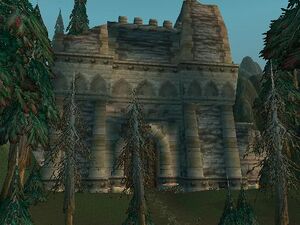
The Greymane Wall, in the south of Silverpine Forest, has been in the game since release, but Gilneas itself remained a closed zone.
With the Cataclysm expansion, Gilneas was finally opened to players as the heavily-phased level 1-12 starting area of the new playable worgen race. The level 1-5 quests take place a year before the Cataclysm, and explain how the worgen curse came to be, how the Gilneans were affected and lastly with the player themselves being infected with the worgen curse.[172]
In-game, Gilneas appears to be a dreary and rainy territory, reflecting the cursed nation itself. The Greymane Wall received a graphical update to match the new style of Gilneas (a regency style). The unphased version of Gilneas, the Ruins of Gilneas, is devoid of any life except for a few critters.
In the RPG
Lord Genn Greymane, a brawny warrior who may be in his seventies, has ruled Gilneas for decades. Greymane never supported the Alliance of Lordaeron in the Second War and argued against its existence from beginning to end. In his own words, he despised the orcs and the Alliance stating that the last thing Gilneas needed was sponges from other nations drawing from their resources, Dalaran wizards meddling with their affairs, and someone else's enemies killing their own soldiers. Gilneas was its own nation and it would always be.[173][174]
Gilneas joined the Alliance in the Second War, but offered only token support, refusing to send more and resolving to confront the orcs on their own. After the Second War, Genn and his people constructed the Greymane Wall effectively separating the peninsula from the rest of Lordaeron, not allowing anyone in or out. None knows what has been transpiring there ever since.[173][174][175][176] Like their leader, Gilneans are burly and gruff. Extremely isolationist, they supported the Greymane Wall's construction. They are probably still beyond the wall, farming, hunting and otherwise supporting their nation. They speak Common, and have their faith in the Holy Light.[173]
During the Third War, refugees from the north camped at Greymane Wall, pleading to be let inside. The gates remained closed, and undead patrols slaughtered them. Perhaps something dire has befallen Gilneas.[173] Rumors of what was transpiring there became the subject of rumors throughout the Alliance - the renowned explorer Brann Bronzebeard theorized that the nation had fallen to the naga as one such example.[174] Ironforge dwarves, seeking allies to help drive the Scourge from Lordaeron, intended to send a diplomatic party to Gilneas. King Magni hired goblin zeppelins to ferry the diplomats and summoned Wildhammer gryphon riders as escorts. Yet no one knew what to expect in Gilneas, so Magni also hired a few trusted mercenaries to accompany his ambassadors.[174]
In Hearthstone
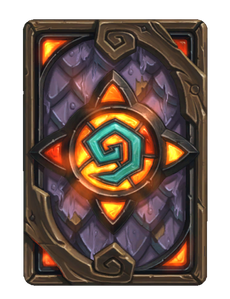
Gilneas is the setting of the Witchwood expansion for Hearthstone. In this scenario, Gilneas City was apparently restored, the Blackwald was twisted by Hagatha the Witch into the Witchwood, Prince Liam returned as a ghost, the Blackhowl joined the Alliance, and Gilnean citizens and allies engaged in hunting corrupted monsters such as treants, aberrations and others.
Film universe
Gilneas participated in the council that would eventually lead to the creation of the Alliance.
Notes and trivia
- It is said that at one time the kingdom of Gilneas had land only at the tip of the peninsula that bears its name.[177]
- A coin fished from Dalaran's fountain called
 [Genn's Copper Coin] reads "Pah, the fountains in Gilneas could grant ten times as many wishes as Dalaran's!".
[Genn's Copper Coin] reads "Pah, the fountains in Gilneas could grant ten times as many wishes as Dalaran's!". - Worgen adventurers raised among the Death Knights of Acherus were Gilneans that were trapped on the other side of the Greymane Wall and became worgen servants of Arugal.[178]
 [Gilneas Sparkling Water] can be purchased in the Old Hillsbrad Foothills section of the Caverns of Time. It replaces
[Gilneas Sparkling Water] can be purchased in the Old Hillsbrad Foothills section of the Caverns of Time. It replaces  [Purified Draenic Water], which wouldn't have been found on Azeroth at the time.
[Purified Draenic Water], which wouldn't have been found on Azeroth at the time.- The tents in Warcraft III have the same symbol that the banner of Gilneas from Warcraft II had. The same symbol is present on the worgen icon, but is missing from the Gilnean flag.
- The change in flags, and as such the removal of the symbol, was originally going to be discussed in World of Warcraft: Chronicle Volume 3,[179] though it was cut from the book. Ultimately, the only statement given on the symbol is that both flags were canon.[180]
- The Gilnean symbol was eventually removed from the tents in Warcraft III: Reforged.
- One of the vulpera jokes mentions that joining the Horde finally allowed them to take revenge on Gilneas for all their fox hunts.
- Gilnean was the planned native language of the Gilneas humans. It briefly appeared during the World of Warcraft: Cataclysm beta, but did not make it to the live game.
- Before the announcement of the draenei as the Alliance race in World of Warcraft: The Burning Crusade, there was speculation that the worgen and Gilneas would enter the game at this stage. The rumor again came out in July 2009 with the revelation of worgen Hallow's End masks. It was finally confirmed at BlizzCon 2009.
- Between the release of the original World of Warcraft and the announcement of Cataclysm, no information was provided about Gilneas or what state the kingdom was in. In response to a question at BlizzCon 2005, Chris Metzen mentioned that the developers had "forgotten" about Gilneas.[181] Later, in an interview at New York Comic Con 2009, he mentioned that Blizzard had some "very, very, very interesting plans for Gilneas", but he would not reveal any further details.[182] Months later at BlizzCon 2009, it was revealed to be that the Gilneans had turned into worgen and had now joined the Alliance.[183]
Inspirations
- The Gilneans' clothing, weapons, architecture, and accents have great Regency Era connotations, which along with Gilneas' cold, gloomy, and rainy weather of the peninsula, seem to have been inspired by nineteenth-century London. There are also elements like the Blackwald from Germany. Some Gilnean buildings, such as Greymane Manor and in Gilneas City, have "onion domes" on them, possibly indicating a Russian influence in elements of their architecture.
- Cut Gilneas content from the Cataclysm alpha indicated that it was to have several inquisitors present, notably around Grimmburg. As such, the kingdom might have originally been intended to be similar to the Germanic-inspired humans of Warhammmer.
- Gilneas cultural inspirations are largely borrowed from various folk magic and pagan traditions of the British Isles and various werewolf mythologies, particularly of Europe.
- The way the Harvest-witches are said to have kept the "old ways" gestures to contemporary claims of Paganism and that of real-world Druids, as well as the cunning folk in Britain.
- The symbol on the Icon of Gilneas and the old flag resembles the astrological symbol for Saturn in Western astrology. Saturn is the Roman god of harvest and agriculture, among other things, which are themes seen with the harvest-witches.
- There can be comparisons between one of the werewolf origin myths of Lycaon of Arcadia and Genn Greymane, as both are kings and turned into werewolves in a story that involves the death of their sons (Lycaon sacrificing his son and trying to trick Zeus, Greymane letting Arugal call upon the worgen to defend against the Scourge, eventually leading to events causing his sons death). Another relevant myth from Pliny the Elder states that once a year a man from the clan of Anthus would hang his clothes on an oak tree and turn into a wolf by swimming into the lake. The Howling Oak and the Blackwald are oak trees.
- "Blackwald" means "Black Forest", referring to the Black Forest, that historically has werewolf folklore.
Speculation
This article or section includes speculation, observations or opinions possibly supported by lore or by Blizzard officials. It should not be taken as representing official lore.
|
- A group of ogres may have invaded the land during the Second War or in its aftermath. Alternatively, they could have arrived via ships after the wall was built.
- Despite the iconography of the wolf being common in Gilneas culture, there are no wolves in Gilneas proper, unlike Silverpine Forest to the north. Having been walled off from the rest of Lordaeron it is possible that wolves were hunted to extinction (as happened in 17th century Britain), since Gilneas seems to be currently home to both sheep husbandry and a hunting culture.
- A single Mistfang Alpha has been added to Gilneas, which can summon Mistfang Howlers, thus finally rectifying the situation. However, it's unknown whether the wolf was already in Gilneas, or if it just wandered in from Silverpine, possibly reintroducing them to the region.
Gallery
Tabard of the Gilneas Liberation Front.
Gilnean boy
A poster warning Gilnean citizens of the worgen.
Gilnean tents in Warcraft III: Reign of Chaos.
- Art
An infected Gilnean in Curse of the Worgen.
Gilnean worgen portrait by Mark Gibbons.
Gilnean worgen male art by Glenn Rane.
Gilneas stagecoach concept art.
The Battle for Gilneas loading screen artwork.
Gilneas' symbol on the Woodcutter's Axe in Hearthstone.
Gilnean shield on a motorbike in Heroes of the Storm.
See also
References
- ^ a b c Curse of the Worgen Issue 5
- ^
 [5-30] A Man Named Godfrey
[5-30] A Man Named Godfrey
- ^ Ultimate Visual Guide, pg. 102
- ^ a b c Wolfheart, chapter 14
- ^ World of Warcraft: Chronicle Volume 1, pg. 133
- ^
 [Legends of the Tidesages]
[Legends of the Tidesages]
- ^ 2017-05-11, BlizzCon 2017 Jeremy Feasel Interview – World of Warcraft: Battle for Azeroth. Blizzplanet, accessed on 2017-11-05
- ^
 [20-60] The Ruins of Gol Var
[20-60] The Ruins of Gol Var
- ^ World of Warcraft: Chronicle Volume 1, pg. 141
- ^
 [The Seven Kingdoms]
[The Seven Kingdoms]
- ^ World of Warcraft: Chronicle Volume 1, pg. 160
- ^ a b c d e f g h i j k l m Lord of His Pack
- ^ Arthas: Rise of the Lich King, pg. 27 & 31
- ^ World of Warcraft: Chronicle Volume 2, pg. 140
- ^ World of Warcraft: Chronicle Volume 2, pg. 152 - 153
- ^ a b Warcraft II: Tides of Darkness manual, Nations of the Alliance, Gilneas
- ^ Tides of Darkness, chapter 5
- ^ Tides of Darkness, chapter 9
- ^ a b Day of the Dragon, chapter 1
- ^ a b c d e Wolfheart, chapter 10
- ^ Tides of Darkness, chapter 16
- ^ World of Warcraft: Chronicle Volume 2, pg. 176
- ^ World of Warcraft: Chronicle Volume 2, pg. 177 - 178
- ^ Beyond the Dark Portal, chapter 7
- ^ World of Warcraft: Chronicle Volume 3, pg. 36
- ^ The Alliance Splinters
- ^ World of Warcraft: Chronicle Volume 3, pg. 34 - 36
- ^ a b c d


 [1-30] Kill or Be Killed
[1-30] Kill or Be Killed
- ^ a b World of Warcraft: Chronicle Volume 3, pg. 60
- ^ World of Warcraft: Chronicle Volume 3, pg. 65
- ^ Lord of His Pack, pg. 11 - Crowley had not accepted the wall with grace. He had defied Greymane and had even aided the Alliance during what was now known as the Third War by sending the "Gilneas Brigade" to Lady Jaina Proudmoore.
- ^ Wolfheart, pg. 218
- ^ Ledger of the Sea Wolf
- ^ Curse of the Worgen Issue 5, pg. 29
- ^
 [10-30] An Old Sea Dog
[10-30] An Old Sea Dog
- ^ Quote by Enormous Shawn Stooker: "We used to roam the seas... 'til that damned King Greymane shut down the harbors in Gilneas! If it weren't for him, we wouldn't be..."
- ^
 [16] WANTED: Baron Longshore
[16] WANTED: Baron Longshore
- ^
 [The Legend of Stalvan]
[The Legend of Stalvan]
- ^ a b c


 [1-30] Old Divisions
[1-30] Old Divisions
- ^


 [1-30] Brothers In Arms
[1-30] Brothers In Arms
- ^


 [1-30] Save Krennan Aranas
[1-30] Save Krennan Aranas
- ^


 [1-30] Lockdown!
[1-30] Lockdown!
- ^

 [20] Hearts of the Pure
[20] Hearts of the Pure
- ^ World of Warcraft: Exploring Azeroth: The Eastern Kingdoms, pg. 99
- ^
 [15] Arugal's Folly
[15] Arugal's Folly
- ^
 [15] Pyrewood Ambush
[15] Pyrewood Ambush
- ^ a b c


 [1-30] The Battle for Gilneas City
[1-30] The Battle for Gilneas City
- ^ Races of World of Warcraft - Worgen. Archived from the original on 2012-06-04.
- ^ Battle for Gilneas battleground description
- ^


 [1-30] At Our Doorstep
[1-30] At Our Doorstep
- ^ a b Curse of the Worgen Issue 2
- ^ Curse of the Worgen Issue 4
- ^
 [5-30] Waiting to Exsanguinate
[5-30] Waiting to Exsanguinate
- ^


 [1-30] Brothers In Arms
[1-30] Brothers In Arms
- ^


 [1-30] Message to Greymane
[1-30] Message to Greymane
- ^


 [1-30] Time to Regroup
[1-30] Time to Regroup
- ^


 [1-30] Last Stand
[1-30] Last Stand
- ^


 [1-30] Sacrifices
[1-30] Sacrifices
- ^


 [1-30] By Blood and Ash
[1-30] By Blood and Ash
- ^


 [1-30] Among Humans Again
[1-30] Among Humans Again
- ^


 [1-30] In Need of Ingredients
[1-30] In Need of Ingredients
- ^


 [1-30] Invasion
[1-30] Invasion
- ^


 [1-30] Alas, Gilneas!
[1-30] Alas, Gilneas!
- ^ Edge of Night
- ^


 [1-30] Neither Human Nor Beast
[1-30] Neither Human Nor Beast
- ^


 [1-30] The Battle for Gilneas City
[1-30] The Battle for Gilneas City
- ^


 [1-30] Vengeance or Survival
[1-30] Vengeance or Survival
- ^


 [1-30] Slowing the Inevitable
[1-30] Slowing the Inevitable
- ^


 [1-30] Knee-Deep
[1-30] Knee-Deep
- ^ World of Warcraft: Sylvanas, pg. 308
- ^


 [1-30] Keel Harbor
[1-30] Keel Harbor
- ^ World of Warcraft: Chronicle Volume 3, pg. 201
- ^


 [1-30] They Have Allies, But So Do We
[1-30] They Have Allies, But So Do We
- ^


 [1-30] Rut'theran Village
[1-30] Rut'theran Village
- ^ Quote by Genn Greymane to Tyrande Whisperwind after


 [1-30] The Howling Oak: "Not at all, priestess. We are very grateful for all that you've offered us here."
[1-30] The Howling Oak: "Not at all, priestess. We are very grateful for all that you've offered us here."
- ^ The events from the Worgen starting experience
- ^


 [1-30] The Howling Oak
[1-30] The Howling Oak
- ^ Wolfheart, chapter 22
- ^ Wolfheart, chapter 28
- ^ Wolfheart, chapter 29
- ^ World of Warcraft: Chronicle Volume 3, pg. 204
- ^
 [5-30] What Tomorrow Brings
[5-30] What Tomorrow Brings
- ^
 [Orders from High Command], from
[Orders from High Command], from  [5-30] On Whose Orders?
[5-30] On Whose Orders?
- ^
 [5-30] Cities in Dust
[5-30] Cities in Dust
- ^
 [15-30] Advice from the Cenarion Circle
[15-30] Advice from the Cenarion Circle
- ^
 [15-30] Demoniac Vessel
[15-30] Demoniac Vessel
- ^
 [15-30] Curtail the Darktail
[15-30] Curtail the Darktail
- ^
 [15-30] A Closer Look
[15-30] A Closer Look
- ^ Denmother Ulrica gossip dialogue
- ^
 [15-30] Enemy at our Roots
[15-30] Enemy at our Roots
- ^
 [10-30] Part of the Pack
[10-30] Part of the Pack
- ^
 [10-30] The Yorgen Worgen
[10-30] The Yorgen Worgen
- ^
 [30-35] Goldrinn's Ferocity
[30-35] Goldrinn's Ferocity
- ^
 [30-35] Howling Mad
[30-35] Howling Mad
- ^

 [35] The Deed is Done
[35] The Deed is Done
- ^

 [35] Assassinate Creed
[35] Assassinate Creed
- ^ Loreology on Twitter (archived)
- ^ Garrosh Hellscream (tactics)#Alliance
- ^ War Crimes, chapter 2
- ^
 [10-45] Stormheim
[10-45] Stormheim
- ^
 [10-45] Combustible Contagion
[10-45] Combustible Contagion
- ^
 [10-45] Cut Out the Heart
[10-45] Cut Out the Heart
- ^ Warden Tower Assault
- ^
 [10-45] A Village in Peril
[10-45] A Village in Peril
- ^
 Unseen Protection: The Mother of Imps
Unseen Protection: The Mother of Imps
- ^
 Bradensbrook Under Attack
Bradensbrook Under Attack
- ^
 [10-45LI WQ] The Taste of Corruption
[10-45LI WQ] The Taste of Corruption
- ^ Before the Storm, chapter 1 & 4
- ^ Before the Storm, chapter 28
- ^ Elegy, pg. 51 - 52
- ^ Elegy, pg. 69
- ^ Elegy, pg. 78
- ^ Elegy, pg. 36
- ^ Elegy, Part Four: "It had not taken more than an hour or two to send all the Gilneans to Stormwind..."
- ^
 Lordamere Lake
Lordamere Lake
- ^
 Gilnean Assault
Gilnean Assault
- ^
 Undead Rising
Undead Rising
- ^
 Shadowfang Plague
Shadowfang Plague
- ^ Blizzcon 2017, Warfront: Stromgarde
- ^
 [60] Waning Hope
[60] Waning Hope
- ^
 [60] Shores of Fate
[60] Shores of Fate
- ^
 [60] Strategic Deployment
[60] Strategic Deployment
- ^ WoW Developer Live Stream with Ion Hazzikostas
- ^
 [Havenswood Salvage]
[Havenswood Salvage]
- ^ Captain Rez'okun says: I have never seen worgen dis feral before. Keep an eye on dese curs while you gather de Azerite.
- ^

 [50] Mevris' Menace
[50] Mevris' Menace
- ^
 [The Cursed Old Wolf]
[The Cursed Old Wolf]
- ^
 [70] Scarlet Blood
[70] Scarlet Blood
- ^
 [70] To Gilneas
[70] To Gilneas
- ^
 [A Red Misssive]
[A Red Misssive]
- ^
 [70] Aderic's Retort
[70] Aderic's Retort
- ^
 [70] Knee-High
[70] Knee-High
- ^
 [70] Hounds of War
[70] Hounds of War
- ^
 [70] Artillerist Arsonist
[70] Artillerist Arsonist
- ^
 [70] Crushing the Crusade
[70] Crushing the Crusade
- ^
 [70] Righteous Fire, Righteous Fury
[70] Righteous Fire, Righteous Fury
- ^
 [70] Beginning a New Dawn
[70] Beginning a New Dawn
- ^


 [50-70] The Shadow of Gilneas
[50-70] The Shadow of Gilneas
- ^
 [Savage Champion's Thorns]
[Savage Champion's Thorns]
- ^ Woodcutter's Axe
- ^ Ultimate Visual Guide, pg. 106 - 107
- ^ Lieutenant Thorn#Quotes
- ^
 [Gilnean Ring of Ruination]
[Gilnean Ring of Ruination]
- ^
 [Silver Gilnean Brooch]
[Silver Gilnean Brooch]
- ^
 [Banded Gilnean Cloak]
[Banded Gilnean Cloak]
- ^ a b c d Races of World of Warcraft: Worgen
- ^ Lorna Crowley#Lock the Doors
- ^


 [1-30] From the Shadows
[1-30] From the Shadows
- ^ Mount Journal entry for
 [Mountain Horse]
[Mountain Horse]
- ^ Harrison McCabe#Quotes
- ^ Introductions Are in Order#Notes
- ^ Curse of the Worgen Issue 3
- ^ Mayor Heathrow, Mayor Charlton Connisport & Mayor Gwen Armstead
- ^
 [15] Pyrewood Ambush
[15] Pyrewood Ambush
- ^ "Cursed or not, you are still bound by Gilnean law!" from


 [1-30] Neither Human Nor Beast
[1-30] Neither Human Nor Beast
- ^ Curse of the Worgen Issue 1
- ^ World of Warcraft: Chronicle Volume 2, pg. 126
- ^



 [1-30] Seek the Sister
[1-30] Seek the Sister
- ^ a b



 [2] Moonfire
[2] Moonfire
- ^ a b Ask CDev Answers - Round 3
- ^
 [10-30] Brood of Seldarria
[10-30] Brood of Seldarria
- ^



 [2] Learning the Word
[2] Learning the Word
- ^ Celestine of the Harvest#Hallow's End
- ^ Genn Greymane#Hallow's End
- ^ Arthas: Rise of the Lich King, chapter 7
- ^ Noblegarden's event description
- ^ Samwise Didier on Twitter: "It is just a little cool charm to ward off the wolf curse. Didn't work apparently."
- ^ a b


 [1-30] Patriarch's Blessing
[1-30] Patriarch's Blessing
- ^


 [1-30] Laid to Rest
[1-30] Laid to Rest
- ^ Warcraft II: Tides of Darkness manual, Nations of the Alliance, Gilneas
- ^ Ultimate Visual Guide, pg. 106
- ^ J. Allen Brack interview
- ^ a b c d Lands of Conflict, pg. 96
- ^ a b c d Lands of Conflict, pg. 97
- ^ Alliance Player's Guide, pg. 134
- ^ World of Warcraft: The Roleplaying Game, pg. 20
- ^ Day of the Dragon, pg. 5
- ^

 [8-30] A Special Surprise
[8-30] A Special Surprise
- ^ Matt Burns on Twitter: "It's something we will look into, likely for Vol. 3."
- ^ Sean Copeland on Twitter
- ^ kotik2 2005-10-29. Reporting from Blizzcon. Enworld.org. Retrieved on 2023-01-14., "...Metzen's comment was "How do we say we forgot about it without saying we forgot about it?""
- ^ Medievaldragon 2009-02-09. Chris Metzen & Micky Neilson Pocket Star Books Lore Q&A Video Interview. Blizzplanet. Retrieved on 2020-02-29.
- ^ Cataclysm features - Worgen
| |||||||||||||||||||

